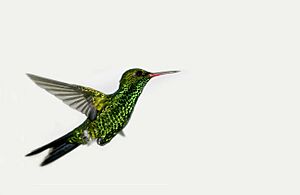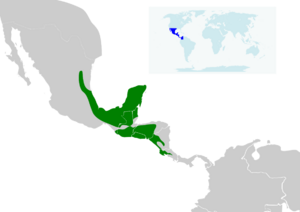Canivet's emerald facts for kids
Quick facts for kids Canivet's emerald |
|
|---|---|
 |
|
| A male in Utila, Honduras | |
| Conservation status | |
| Scientific classification | |
| Genus: |
Cynanthus
|
| Species: |
canivetii
|
 |
|
| Range of C. canivetii | |
| Synonyms | |
|
Chlorostilbon canivetii |
|
The Canivet's emerald (Cynanthus canivetii) is a beautiful type of hummingbird. It is known for its bright, shiny green feathers. You can find these tiny birds in several countries in Central America, including Belize, Costa Rica, El Salvador, Guatemala, Honduras, Mexico, and Nicaragua.
Contents
About the Canivet's Emerald
The Canivet's emerald is a small, fast-flying bird. It belongs to a group of hummingbirds often called "emeralds" because of their sparkling green colors. This bird was named after a French bird expert, Emmanuel Canivet de Carentan.
What Does It Look Like?
Canivet's emeralds are quite small. Male birds are about 7.8 to 9.3 centimeters (around 3 to 3.7 inches) long. They weigh about 2.1 to 2.8 grams, which is less than a penny! Females are a bit smaller, around 7.5 to 8.6 centimeters long.
Male Birds
Male Canivet's emeralds are very colorful. They have a bright, shiny golden-green head and body. Their bill is usually red with a black tip. They also have a long, forked tail that looks blue-black or black with a blue shine. This tail is one of their most noticeable features.
Female Birds
Female Canivet's emeralds are also pretty, but not as flashy as the males. Their upper body and sides are bright metallic green. They have a grayish-white stripe behind their eye and light gray feathers on their belly. Their tail is not as long or deeply forked as the male's. It has green and bluish-green feathers with black bands and white tips.
Where Do They Live?
Canivet's emeralds live in many parts of Central America. They can be found from eastern Mexico all the way down to Costa Rica. They like places that are dry or partly dry, with open spaces. You might see them at the edges of evergreen forests, in secondary forests (forests that have grown back after being cut), scrubby grasslands, and even in gardens! They usually live from sea level up to about 1,900 meters (about 6,200 feet) high.
How Do They Behave?
Canivet's emeralds are busy birds! They stay in the same areas all year round and do not migrate.
Eating Habits
These hummingbirds mostly eat nectar from flowers. They are very smart about finding food. They use a method called "trap-lining," which means they visit a set path of flowering plants over and over again. They often feed from small flowers that other hummingbirds might ignore. They also eat tiny arthropods, like small insects, to get enough protein. When they drink nectar, they often hold their tail partly open and wag it.
Building Nests
Canivet's emeralds build their nests in different months depending on where they live. For example, in eastern Mexico, they breed from February to May. Their nest is shaped like a cup and is made from plant fibers and soft down. They often decorate the outside with small pieces of bark. Nests are usually placed about 1 to 3 meters (3 to 10 feet) above the ground.
Their Sounds
The song of the Canivet's emerald is described as a repeated, wiry sound like "tseee tseeree." Their call is a dry, scratchy sound, sometimes like a soft, quick chatter.
Are They Safe?
Good news! The Canivet's emerald is considered a species of "Least Concern" by the IUCN (International Union for Conservation of Nature). This means they are not currently endangered. There are at least 500,000 adult birds, and their numbers seem to be stable. They are good at living in places that have been changed by people, like gardens, so human activity doesn't seem to harm them much in the short term.
Images for kids



